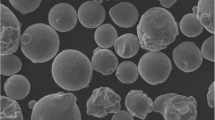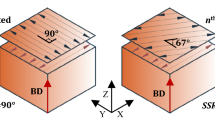Abstract
Additive manufacturing (AM) technologies associated with metal cutting, as in hybrid manufacturing, are able to produce parts of complex shapes, which could hardly be fabricated by other conventional processes. Stainless steel parts made by AM in layer-by-layer deposition can be used in microdevices intended to several applications in many fields. The possibility of achieving a very high level of details and surface finishing control by micromachining could introduce a relevant approach to produce microdevices with low roughness and less geometrical deviations. However, material response during microcutting has been pointed as a relevant issue when dealing with AM processes. The present work aims at investigating important aspects when micro-endmilling of stainless steel AISI 316L produced by AM. Workpieces were produced by powder bed fusion (PBF) process and micro-endmilled with different ball nose micromills (600 and 800 μm diameters). Spindle rotation was 32,000 rpm, depth of cut was 100 μm, and feed per tooth was from 0.5 to 3 μm performing full slot in all trials. The machining was carried out changing the toolpath direction in specific angles (60°, 90°, 120° and 180°) along the slot length. Roughness parameters were measured in different surfaces inside the slot, in an attempt to assess geometrical deviations, surface finishing and any material anisotropy. Analysis of variance (ANOVA) and post hoc comparisons using the Tukey test showed the effect of two main parameters (cutting direction and cutting parameters) on surface roughness. The results indicate that Rz parameter is sensitive to anisotropy effects when reducing endmill diameter. Better groove formation is noticed when using higher tool size and a better microchannel quality was found when both values, feed per tooth and cutting edge radius, are close to each other.














Similar content being viewed by others
References
Leach RK, Bourell D, Carmignato S, Donmez A, Senin N, Dewulf W (20019) Geometrical metrology for metal additive manufacturing. CIRP Ann 68:677–700. https://doi.org/10.1016/j.cirp.2019.05.004
Liu S, Shin YC (2019) Additive manufacturing of Ti6Al4V alloy: a review. Mater Design 164:107552. https://doi.org/10.1016/j.matdes.2018.107552
Kok Y, Tan XP, Wang P, Nai MLS, Loh NH, Liu E, Tor SB (2018) Anisotropy and heterogeneity of microstructure and mechanical properties in metal additive manufacturing: a critical review. Mater Design 139:565–586. https://doi.org/10.1016/j.matdes.2017.11.021
Chou R, Ghosh A, Chou SC, Paliwal M, Brochu M (2017) Microstructure and mechanical properties of Al10SiMg fabricated by pulsed laser powder bed fusion. Mat Sci Eng A 689:53–62. https://doi.org/10.1016/j.msea.2017.02.023
Wilson-Heid AE, Qin S, Beese AM (2018) Anisotropic multiaxial plasticity model for laser powder bed fusion additively manufactured Ti-6Al-4V. Mat Sci Eng A 738:90–97. https://doi.org/10.1016/j.msea.2018.09.077
Zou J, Gaber Y, Voulazeris G, Li S, Vazquez L, Liu L-F, Yao M-Y, Wang F-J, Holynski M, Bongs K, Attallah MM (2018) Controlling the grain orientation during laser powder bed fusion to tailor the magnetic characteristics in a Ni-Fe based soft magnet. Acta Mater 158:230–238. https://doi.org/10.1016/j.actamat.2018.07.064
Han Q, Mertens R, Montero-Sistiaga ML, Yang S, Setchi R, Vanmeensel K, Van Hooreweder B, Evans SL, Fan H (2018) Laser powder bed fusion of Hastelloy X: effects of hot isostatic pressing and the hot cracking mechanism. Mat Sci Eng A 732:228–239. https://doi.org/10.1016/j.msea.2018.07.008
Simons M (2018) Additive manufacturing—a revolution in progress? Insights from a multiple case study. Int J Adv Manuf Technol 96:735–749. https://doi.org/10.1007/s00170-018-1601-1
Lewandowski JJ, Seifi M (2016) Metal additive manufacturing: a review of mechanical properties. Annu Rev Mater Res 46:151–186. https://doi.org/10.1146/annurev-matsci-070115-032024
Kovaci H (2019) Comparison of the microstructural, mechanical and wear properties of plasma oxidized Cp-Ti prepared by laser powder bed fusion additive manufacturing and forging processes. Surf Coat Technol 374:987–996. https://doi.org/10.1016/j.surfcoat.2019.06.095
Zitelli C, Folgarait P, Di Schino A (2019) Laser powder bed fusion of stainless steel grades: a review. Metals 9:731. https://doi.org/10.3390/met9070731
Grasso M, Colosimo BM (2017) Process defects and in situ monitoring methods in metal powder bed fusion: a review. Meas Sci Technol 28:044005. https://doi.org/10.1088/1361-6501/aa5c4f
Essa K, Modica F, Imbaby M, El-Sayed MA, ElShaer A, Jiang K, Hassanin H (2017) Manufacturing of metallic micro-components using hybrid soft lithography and micro-electrical discharge machining. Int J Adv Manuf Technol 91:445–452. https://doi.org/10.1007/s00170-016-9655-4
Strano G, Hao L, Everson RM, Evans KE (2013) Surface roughness analysis, modelling and prediction in selective laser melting. J Mater Process Technol 213:589–597. https://doi.org/10.1016/j.jmatprotec.2012.11.011
Chu WS, Kim CS, Lee HT, Choi JO, Park JI, Song JH, Jang KH, Ahn SH (2014) Hybrid manufacturing in micro/nano scale: a review. Int J Precis Eng and Manuf -Green Tech 1:75–92. https://doi.org/10.1007/s40684-014-0012-5
Vaezi M, Seitz H, Yang S (2013) A review on 3D micro-additive manufacturing technologies. Int J Adv Manuf Technol 67:1721–1754. https://doi.org/10.1007/s00170-012-4605-2
Willert M, Riemer O, Brinksmeier E (2016) Size effect in micro machining of steel depending on the material state. Procedia CIRP 46:193–196. https://doi.org/10.1016/j.procir.2016.03.187
Gao S, Pang S, Jiao L, Yan P, Luo Z, Yi J, Wang X (2017) Research on specific cutting energy and parameter optimization in micro-milling of heat-resistant stainless steel. Int J Adv Manuf Technol 89:191–205. https://doi.org/10.1007/s00170-016-9062-x
Hajiahmadi S (2019) Burr size investigation in micro milling of stainless steel 316L. International Journal of Lightweight Materials and Manufacture 2:296–304. https://doi.org/10.1016/j.ijlmm.2019.07.004
Oliaei SNB, Karpat Y (2016) Influence of tool wear on machining forces and tool deflections during micro milling. Int J Adv Manuf Technol 84:1963–1980. https://doi.org/10.1007/s00170-015-7744-4
Aurich JC, Reichenbach IG, Schüler GM (2012) Manufacture and application of ultra-small micro end mills. CIRP Ann 61:83–86. https://doi.org/10.1016/j.cirp.2012.03.012
Wu X, Li L, He N (2017) Investigation on the burr formation mechanism in micro cutting. Precis Eng 47:191–196. https://doi.org/10.1016/j.precisioneng.2016.08.004
Boswell B, Islam MN, Davies IJ (2018) A review of micro-mechanical cutting. Int J Adv Manuf Technol 94:789–806. https://doi.org/10.1007/s00170-017-0912-y
De Assis CLF, Jasinevicius RG, Rodrigues AR (2015) Micro end-milling of channels using ultrafine-grained low-carbon steel. Int J Adv Manuf Technol 77:1155–1165. https://doi.org/10.1007/s00170-014-6503-2
Liverani E, Toschi S, Ceschini L, Fortunato A (2017) Effect of selective laser melting (SLM) process parameters on microstructure and mechanical properties of 316L austenitic stainless steel. J Mater Process Technol 249:255–263. https://doi.org/10.1016/j.jmatprotec.2017.05.042
Yakout M, Elbestawi MA (2019) Veldhuis SC, Density and mechanical properties in selective laser melting of invar 36 and stainless steel 316L. J Mater Process Technol 266:397–420. https://doi.org/10.1016/j.jmatprotec.2018.11.006
Popovich VA, Borisov EV, Popovich AA, Sufiiarov VS, Masaylo DV, Alzina L (2017) Functionally graded Inconel 718 processed by additive manufacturing: crystallographic texture, anisotropy of microstructure and mechanical properties. Mater Design 114:441–449. https://doi.org/10.1016/j.matdes.2016.10.075
Kruth J-P, Van der Schueren B, Bonse JE, Morren B (1996) Basic powder metallurgical aspects in selective metal powder sintering. CIRP Ann 45:183–186. https://doi.org/10.1016/S0007-8506(07)63043-1
Pallant J (2011) Survival manual. Open University Press, Maidenhead
Gadelmawla ES, Koura MM, Maksoud TMA, Elewa IM, Soliman HH (2002) Roughness parameters. J Mater Process Technol 123:133–145. https://doi.org/10.1016/S0924-0136(02)00060-2
Acknowledgements
Authors would like to give thanks to the Technological Research Institute of Sao Paulo (IPT) for providing laboratory facilities and Mitsubishi Materials for the cutting tools.
Funding
This work was supported by the National Council of Scientific and Technological Development (CNPq) (grant 468309/2014-4).
Author information
Authors and Affiliations
Contributions
Cleiton Assis: supervision, conceptualization, methodology, validation, formal analysis, investigation, writing-original draft preparation, funding acquisition. Guilherme Mecelis: investigation, formal analysis, writing-reviewing and editing. Reginaldo Coelho: supervision, resources, writing-reviewing and editing, funding acquisition.
Corresponding author
Ethics declarations
Conflict of interest
The authors declare that they have no conflict of interest.
Additional information
Publisher’s note
Springer Nature remains neutral with regard to jurisdictional claims in published maps and institutional affiliations.
Rights and permissions
About this article
Cite this article
de Assis, C.L.F., Mecelis, G.R. & Coelho, R.T. An investigation of stainless steel 316L parts produced by powder bed fusion submitted to micro-endmilling operations. Int J Adv Manuf Technol 109, 1867–1880 (2020). https://doi.org/10.1007/s00170-020-05710-2
Received:
Accepted:
Published:
Issue Date:
DOI: https://doi.org/10.1007/s00170-020-05710-2




